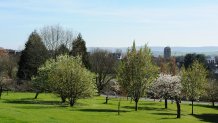Articles

The trees provide more than £20,422 of environmental benefits each year
University of Exeter trees remove pollution equivalent to emissions from 798 family cars
The thousands of trees at the University of Exeter remove pollution equivalent to emissions from 798 family cars from the atmosphere every year, research shows.
New calculations show the 5,000 trees surveyed, from 328 species and six continents, capture 36 tonnes of carbon annually. They also stop 4,217 m³ a year of water – two Olympic swimming pools – from flooding local rivers and remove two tonnes of pollutants from the air.
The trees provide more than £20,422 of environmental benefits each year and take away from the environment the equivalent of nitrogen dioxide caused by 90 family cars and sulphur dioxide from 798 family cars annually.
The figures were calculated using computer software which estimates environmental benefits based on the size of the trees. The total area of the leaves of all the trees surveyed on campus is estimated to be 1,501,000m2. If all the layers of leaves within the tree canopies were spread out, they would cover an area greater than 168 football pitches.
One Monterey Pine alone produces 6,340kg of oxygen a year and filters more than 1kg of airborne pollutants, as well as capturing 3m3 of rainwater, reducing surface run-off.
Trees also support other plants and animals. One Oak supports 300 species of lichen, more than 200 species of insect and 30 species of birds every year.
The environmental benefits of the trees are emphasised this week with new signs on display around campus, to coincide with the University hosting the Arboricultural Association’s National Amenity Conference.
The oldest trees on the University of Exeter’s 114 hectares Streatham Campus are around 200 years old. These were planted when Richard Thornton West, an East Indian merchant, bought the Duryard Estate and built a new house, Reed Hall, which still stands on campus. He spent a fortune on his new home and £70,000 on improving the land, including employing the leading Veitch horticulturalists to lay out the grounds. He wanted expensive rare and unique plants and trees in his estate to show off his wealth. Because of this the University of Exeter’s campus contains many unusual plants and trees from the Americas and Asia. When planted it would have been the first time they had been seen in the UK.
After the death of Richard’s son in 1901 the estate had become derelict until it was taken over by what was then the South West’s University College in 1922.
The University’s Grounds Team are working in partnership with researchers at the Royal Botanic Gardens in Edinburgh to assess if Conifers can play a bigger role in providing timber in the UK. Rare Conifers have been planted in two locations on campus. Oak trees have been planted in the Lower Hoopern Valley as part of a project run in partnership with the Woodland Trust.
Among the most attractive trees on campus are the Cercis, which have beautiful purple-coloured leaves in Autumn and the “leaning” tree near the Duryard Halls of Residence, which bent naturally after being planted. Other notable trees are the Ashes along Prince of Wales Road, Washington Singer side.
Iain Park, Director of Grounds, said: “Picking our favourite trees and plants is a bit like picking your favourite child. I like the Snakebark Maples and the Sweetgums, which both look wonderful in Autumn. The Ash tree outside the Geoffrey Pope building and the Acer outside the Forum also have spectacular colours.
"But as well as looking attractive these trees also bring very important environmental benefits to Exeter, playing their part in keeping the City cleaner and greener. We know how crucial they are and take our role as custodians very seriously.”
Date: 11 September 2017
